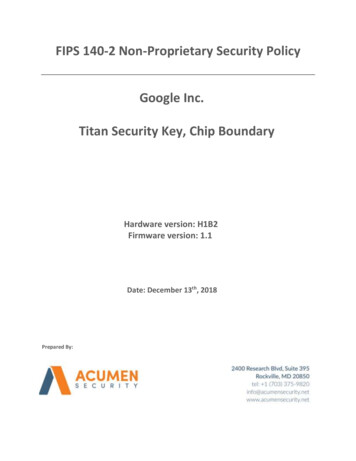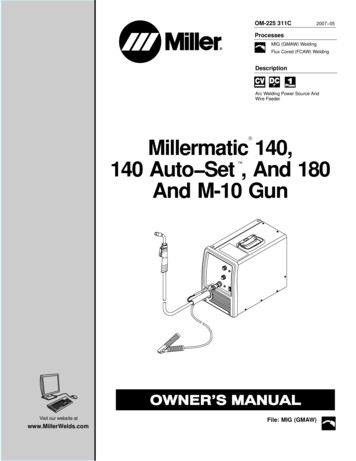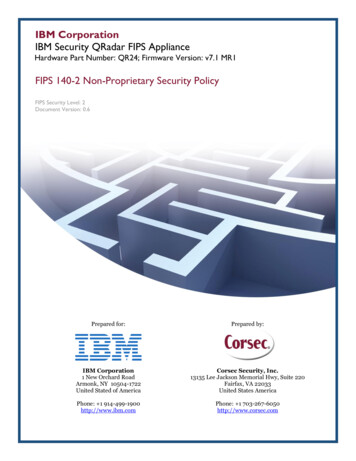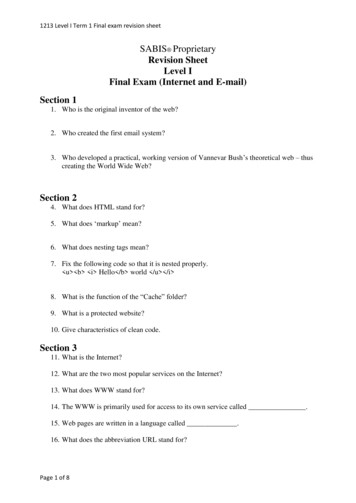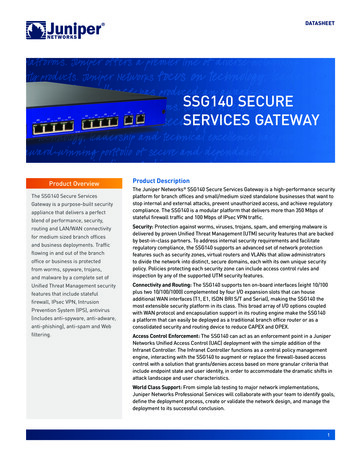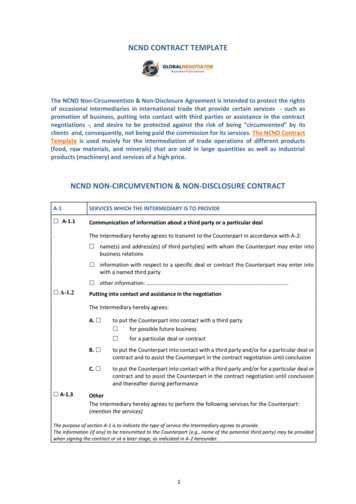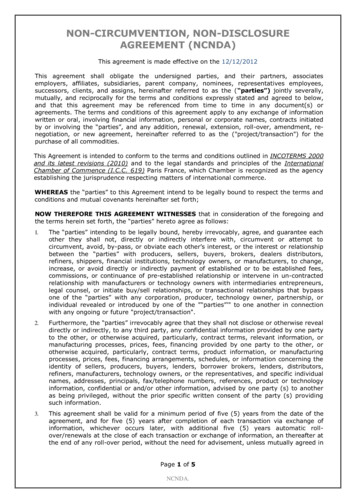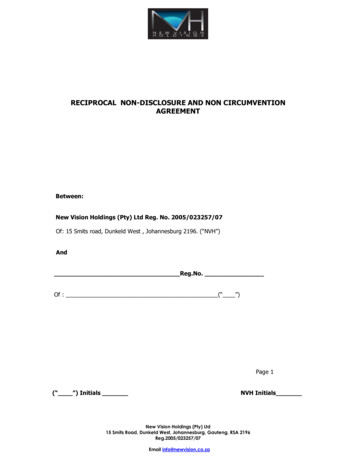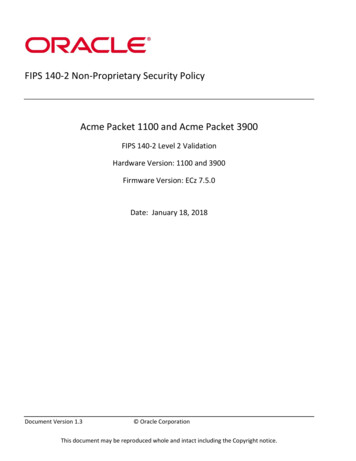
Transcription
FIPS 140-2 Non-Proprietary Security PolicyAcme Packet 1100 and Acme Packet 3900FIPS 140-2 Level 2 ValidationHardware Version: 1100 and 3900Firmware Version: ECz 7.5.0Date: January 18, 2018Document Version 1.3 Oracle CorporationThis document may be reproduced whole and intact including the Copyright notice.
Title: Acme Packet 1100 and Acme Packet 3900 Security PolicyDate: January 18, 2018Author: Acumen Security, LLC.Contributing Authors:Oracle Communications EngineeringOracle Security Evaluations – Global Product SecurityOracle CorporationWorld Headquarters500 Oracle ParkwayRedwood Shores, CA 94065U.S.A.Worldwide Inquiries:Phone: 1.650.506.7000Fax: 1.650.506.7200oracle.comCopyright 2018, Oracle and/or its affiliates. All rights reserved. This document is provided for information purposes only andthe contents hereof are subject to change without notice. This document is not warranted to be error-free, nor subject to any otherwarranties or conditions, whether expressed orally or implied in law, including implied warranties and conditions of merchantability orfitness for a particular purpose. Oracle specifically disclaim any liability with respect to this document and no contractual obligations areformed either directly or indirectly by this document. This document may reproduced or distributed whole and intact including this copyrightnotice.Oracle and Java are registered trademarks of Oracle and/or its affiliates. Other names may be trademarks of their respective owners.Acme Packet 1100 and 3900 Security Policyi
TABLE OF CONTENTSSection1.Overview . 1Document Organization . 1Acme Packet 1100 & 3900 . 22.13.PageIntroduction . 11.11.22.TitleFunctional Overview . 2Cryptographic Module Specification. 33.13.23.33.43.5Definition of the Cryptographic Module . 3FIPS 140-2 Validation Scope . 3Approved or Allowed Security Functions . 4Non-Approved But Allowed Security Functions . 5Non-Approved Security Functions . 54.Module Ports and Interfaces . 75.Physical Security . 106.Roles and Services . 116.16.26.36.3.16.3.26.47.Self-Tests . 207.17.1.17.1.27.1.37.27.38.8.18.29.Operator Services and Descriptions . 11Unauthenticated Services and Descriptions . 14Operator Authentication . 14Crypto-Officer: Password-Based Authentication . 14User: Certificate-Based Authentication . 15Key and CSP Management . 15Power-Up Self-Tests. 20Firmware Integrity Test . 20Mocana Self-Tests . 20OpenSSL Self-tests . 20Critical Functions Self-Tests . 20Conditional Self-Tests . 21Crypto-Officer and User Guidance . 22Secure Setup and Initialization . 22AES-GCM IV Construction/Usage. 22Mitigation of Other Attacks . 2310. Appendices . 2410.110.1Acronyms, Terms and Abbreviations . 24References . 25Acme Packet 1100 and 3900 Security Policyii
List of TablesTable 1: FIPS 140-2 Security Requirements . 4Table 2: FIPS Approved or Allowed Security Functions . 5Table 3: Non-Approved but Allowed Security Functions . 5Table 4: Non-Approved Disallowed Functions . 5Table 5 – Mapping of FIPS 140 Logical Interfaces to Physical Ports . 7Table 6 – Physical Ports . 8Table 7 - Security Mechanism Inspection and Test. 10Table 8 – Service Summary . 11Table 9 – Operator Services and Descriptions . 13Table 10 – Operator Services and Descriptions . 14Table 11 – Crypto-Officer Authentication . 15Table 12 – Crypto-Officer Authentication . 15Table 13 – CSP Table . 19Table 14 – Acronyms . 24Table 15 – References . 25List of FiguresFigure 1: Acme Packet 1100 . 3Figure 2: Acme Packet 3900 . 3Figure 3: Acme Packet 1100 – Front View . 8Figure 4: Acme Packet 1100 – Rear View. 8Figure 5: Acme Packet 3900 – Front View . 8Figure 6: Acme Packet 3900 – Rear View. 9Acme Packet 1100 and 3900 Security Policyiii
1. Introduction1.1 OverviewThis document is the Security Policy for the Acme Packet 1100 and 3900 appliances manufactured by OracleCorporation. Acme Packet 1100 and 3900 are also referred to as “the module or module”. This Security Policyspecifies the security rules under which the module shall operate to meet the requirements of FIPS 140-2 Level 2.It also describes how the Acme Packet 1100 and 3900 appliances function in order to meet the FIPS requirements,and the actions that operators must take to maintain the security of the modules.This Security Policy describes the features and design of the Acme Packet 1100 and 3900 modules using theterminology contained in the FIPS 140-2 specification. FIPS 140-2, Security Requirements for CryptographicModules specifies the security requirements that will be satisfied by a cryptographic module utilized within asecurity system protecting sensitive but unclassified information. The NIST/CSEC Cryptographic Module ValidationProgram (CMVP) validates cryptographic modules to FIPS 140-2. Validated products are accepted by the Federalagencies of both the USA and Canada for the protection of sensitive or designated information.1.2 Document OrganizationThe Security Policy document is one document in a FIPS 140-2 Submission Package. In addition to this document,the Submission Package contains: Oracle Non-Proprietary Security PolicyOracle Vendor Evidence documentFinite State MachineEntropy Assessment DocumentOther supporting documentation as additional referencesWith the exception of this Non-Proprietary Security Policy, the FIPS 140-2 Validation Documentation is proprietaryto Oracle and is releasable only under appropriate non-disclosure agreements. For access to these documents,please contact Oracle.Acme Packet 1100 and 3900 Security PolicyPage 1 of 25
2. Acme Packet 1100 & 39002.1 Functional OverviewThe Acme Packet 1100 and 3900 appliances are specifically designed to meet the unique price performance andmanageability requirements of the small to medium sized enterprise and remote office/ branch office. Ideal forsmall site border control and Session Initiation Protocol (SIP) trunking service termination applications, the AcmePacket 1100 and 3900 appliances deliver Oracle’s industry leading ESBC capabilities in a small form factorappliance. With support for high availability (HA) configurations, TDM fallback, hardware assisted transcoding andQuality of Service (QoS) measurement, the Acme Packet 1100 and 3900 appliances are a natural choice whenuncompromising reliability and performance are needed in an entry-level appliance. With models designed for thesmallest branch office to the largest data center, the Acme Packet ESBC product family supports distributed,centralized, or hybrid SIP trunking topologies.Acme Packet 1100 and 3900 appliances address the unique connectivity, security, and control challengesenterprises often encounter when extending real-time voice, video, and UC sessions to smaller sites. Theappliances also helps enterprises contain voice transport costs and overcome the unique regulatory compliancechallenges associated with IP telephony. TDM fallback capabilities ensure continuous dial out service at remotesites in the event of WAN or SIP trunk failures. Stateful high availability configurations protect against link andhardware failures. An embedded browser based graphical user interface (GUI) simplifies setup and administrationAcme Packet 1100 and 3900 Security PolicyPage 2 of 25
3. Cryptographic Module Specification3.1 Definition of the Cryptographic ModuleThe module consists of the Acme Packet 1100 and Acme Packet 3900 appliances running firmware version ECz7.5.0 on hardware platform 1100 and 3900. The module is classified as a multi-chip standalone cryptographicmodule. The physical cryptographic boundary for the Acme Packet 1100 is defined as the module case and allcomponents within the case. The physical cryptographic boundary for the Acme Packet 3900 is all componentswith exception of the removable power supplies.A representation of the cryptographic boundary is defined below:Figure 1: Acme Packet 1100Figure 2: Acme Packet 39003.2 FIPS 140-2 Validation ScopeThe Acme Packet 1100 and 3900 appliances are being validated to overall FIPS 140-2 Level 2 requirements. SeeTable 1 below.Acme Packet 1100 and 3900 Security PolicyPage 3 of 25
Security Requirements SectionCryptographic Module SpecificationCryptographic Module Ports and InterfacesRoles and Services and AuthenticationFinite State Machine ModelPhysical SecurityOperational EnvironmentCryptographic Key ManagementEMI/EMCSelf-TestsDesign AssuranceMitigation of Other AttacksLevel22222N/A2223N/ATable 1: FIPS 140-2 Security Requirements3.3 Approved or Allowed Security FunctionsThe Acme Packet 1100 and 3900 appliances contain the following FIPS Approved Algorithms listed in Table 2:Approved or Allowed Security FunctionsCertificateSymmetric AlgorithmsAESTriple DESOpenSSL: (CBC, GCM); Encrypt/Decrypt; Key Size 128, 2564547Mocana: (CBC); Encrypt/Decrypt; Key Size 128, 2564548OpenSSL: (CBC); Encrypt/Decrypt; Key Size 1922421Mocana: (CBC); Encrypt/Decrypt; Key Size 1922422Secure Hash Standard (SHS)SHSOpenSSL: SHA-1, SHA-256, SHA-3843725Mocana: SHA-1, SHA-2563726Data Authentication CodeHMACOpenSSL: HMAC-SHA-1, HMAC-SHA-256, HMAC-SHA-3843001Mocana: HMAC-SHA-1, HMAC-SHA-2563002Asymmetric AlgorithmsRSAOpenSSL:RSA: FIPS186-4:186-4KEY(gen): FIPS186-4 Random eALG[ANSIX9.31] SIG(gen) (2048 SHA(256 , 384))SIG(Ver) (2048 SHA(1, 256, 384))2475RSA: FIPS186-2 (not used by the module)Signature Generation 9.31:Modulus lengths: 4096SHAs: SHA-256, SHA-384Mocana:RSA: 186-4:186-4KEY(gen): FIPS186-4 Random eSIG(Ver) (1024 SHA(1); (2048 SHA (1))2476Acme Packet 1100 and 3900 Security PolicyPage 4 of 25
Approved or Allowed Security FunctionsECDSAOpenSSL: FIPS186-4:PKG: CURVES ( P-256 P-384 Testing Candidates )SigGen: CURVES ( P-256: (SHA-256, 384) P-384: (SHA-256, 384)SigVer: CURVES ( P-256: (SHA-256, 384) P-384: (SHA-256, 384) )Certificate1106Random Number GenerationDRBGOpenSSL:CTR DRBG: [ Prediction Resistance Tested: Not Enabled; BlockCipher Use df: ( AES-256 )]Hash Based DRBG: [ Prediction Resistance Tested: Not Enabled ( SHA-1 )1499Note: While implemented, CTR DRBG is not used by the module.Key EstablishmentKey DerivationOpenSSL: SNMP KDF, SRTP KDF, TLS KDFCVL 1223Mocana: IKEv1 KDF (tested but not used by module), SSH KDFCVL 1224Table 2: FIPS Approved or Allowed Security Functions3.4 Non-Approved But Allowed Security FunctionsThe following are considered non-Approved but allowed security functions:AlgorithmUsageDiffie-HellmanKey agreement, key establishment methodology provides 112-bits of encryption strength, noncompliant less than 112 bits of encryption strength.RSA Key WrappingKey wrapping, key establishment methodology provides 112-bits of encryption strength, noncompliant less than 112 bits of encryption strength.NDRNGUsed for seeding NIST SP 800-90A DRBG.MD5Message digest used in TLS only.Table 3: Non-Approved but Allowed Security Functions3.5 Non-Approved Security FunctionsThe following services are considered non-Approved and may not be used in a FIPS-approved mode of operation:ServiceNon-Approved Security FunctionsSSHHashing: MD5, MACing: HMAC MD5 Symmetric: DESTLSMACing: HMAC MD5 Symmetric: DES, RC4SNMPHashing: MD5, MACing: HMAC MD5 Symmetric: DESDiffie-HellmanKey agreement, less than 112 bits of encryption strength.RSA Key WrappingKey wrapping, less than 112 bits of encryption strength.Table 4: Non-Approved Disallowed FunctionsAcme Packet 1100 and 3900 Security PolicyPage 5 of 25
Services listed in the previous table make use non-compliant cryptographic algorithms. Use of these algorithmsare prohibited in a FIPS-approved mode of operation. These services are allowed in FIPS mode when usingallowed algorithms (as specified in section 8.1).Acme Packet 1100 and 3900 Security PolicyPage 6 of 25
4. Module Ports and InterfacesThe table below provides the mapping of ports as per FIPS 140-2 Standard.LogicalInterfaceData InputPhysical Port 1100Ethernet INT/EXT PortsPhysical Port 3900Ethernet SFP PortsP0,1,2,3TDM PortsData OutputCipher textPlain textEthernet INT/EXT PortsEthernet SFP PortsP0,1,2,3TDM PortsControl InputInformation Input/OutputCipher textPlain textConsole PortConsole PortReset ButtonReset ButtonT1/E1 TDM portPower SwitchEthernet MGT PortT1/E1
Other supporting documentation as additional references With the exception of this Non-Proprietary Security Policy, the FIPS 140-2 Validation Documentation is proprietary to Oracle and is releasable only under appropriate non-disclosure agreements. For access to
